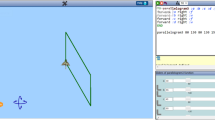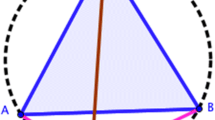Abstract
This paper provides an instrumental account of precalculus students’ graphical process for solving polynomial inequalities. It is carried out in terms of the students’ instrumental schemes as mediated by handheld graphing calculators and in cooperation with their classmates in a classroom setting. The ethnographic narrative relays an instrumental sociogenetic account of mathematical knowledge construction and foregrounds a progressive evolution of mathematical knowledge from the concrete to the abstract phase.
Similar content being viewed by others
References
Artigue, M.: 2003, ‘Learning mathematics in a CAS environment: The genesis of a reflection about instrumentation and the dialectics between technical and conceptual work’, Proceedings of the CAME 2001 Symposium: Communicating Mathematics Through Computer Algebra Systems, available at http://ltsn.mathstore.ac.uk/ came/events/freudenthal/theme1.html.
Arzarello, F., Bartolini Bussi, M. and Robutti, O.: 2004, ‘Infinity as a multi-faceted concept in history and in the mathematics classroom’, in M. J. Johnsen Hóines and A. B. Fuglestad (eds.), Proceedings of the 28th Conference of the International Group for the Psychology of Mathematics Education, Vol. 4, Bergen University College, Norway, pp. 89–96.
Balacheff, N. and Sutherland, R.: 1994, ‘Epistemological domain of validity of microworlds: The case of Logo and Cabri-geometre’, in R. Lewis and P. Mendelsohn (eds.), Lessons From Learning, IFIP Conference TC3WG3.3, North Holland, pp. 137–150.
Bartolini Bussi, M.: 1998, ‘Joint activity in mathematics classrooms: A Vygotskian analysis’, in F. Seeger, J. Voigt and U. Waschescio (eds.), The Culture of the Mathematics Classroom, Cambridge University Press, New York, pp. 13–49.
Bartolini Bussi, M. and Boni, M.: 2003, ‘Instruments for semiotic mediation in primary school classrooms’, For the Learning of Mathematics 23(2), 15–22.
Béguin, P. and Rabardel, P.: 2000, ‘Designing for instrument-mediated activity’, Scandinavian Journal of Information Systems 12, 173–190.
Bottino, R. and Chiappini, G.: 2002, ‘Advanced technology and learning environments: Their relationships within the arithmetic problem-solving domain’, in L. English (ed.), Handbook of International Research in Mathematics Education, Lawrence Erlbaum Associates, Mahwah, New Jersey, pp. 757–786.
Bruner, J.: 1987, ‘Prologue to the English edition’, in R. Rieber and A. Carton (eds.), The Collected Works of L. S. Vygotsky, Volume 1: Problems of General Psychology, Plenum Press, New York, pp. 1–16.
Cobb, P.: 1999, ‘Individual and collective mathematical development: The case of statistical data analysis’, Mathematical Thinking and Learning 1, 5–44.
Cobb, P.: 1994, ‘Where is the mind? Constructivist and sociocultural perspectives on mathematical development’, Educational Researcher 23(7), 13–20.
Cobb, P., Yackel, E. and McClain, K.: 2000, Symbolizing and Communicating Mathematics Classrooms: Perspectives on Discourse, Tools, and Instructional Design, Lawrence Erlbaum Associates, Mahwah, New Jersey.
Cobb, P. and Yackel, E.: 1996, ‘Constructivist, emergent, and sociocultural perspectives in the context of developmental research’, Educational Psychologist 31, 175–190.
Cobb, P., Wood, T. and Yackel, E.: 1992, ‘Learning and interaction in classroom situations’, Educational Studies in Mathematics 23, 99–122.
Gravemeijer, K., Lehrer, R., van Oers, B. and Verschaffel, L.: 2002, Symbolizing, Modeling, and Tool Use in Mathematics Education, Kluwer, Dordrecht.
Guin, D. and Trouche, L.: 2002, ‘Mastering by the teacher of the instrumental genesis in CAS environments: Necessity of instrumental orchestrations’, ZDM 34(5), 204–211.
Jones, K.: 2000, ‘Providing a foundation for deductive reasoning: Students’ interpretations when using dynamic geometry software and their evolving mathematical explanations’, Educational Studies in Mathematics 44, 55–85.
Kaput, J.: 1991, ‘Notations and representations as mediators of constructive processes’, in E. von Glasersfeld (ed.), Constructivism in Mathematics Education, Kluwer, Dordrecht, pp. 53–74.
Kozulin, A.: 1998, Psychological Tools, Harvard University Press, Cambridge, Massachusetts.
Kuuti, K. and Kaptelinin, V.: 1997, ‘Rethinking cognitive tools: From augmentation to mediation’, Proceedings of the 2nd International Conference on Cognitive Technology, available at http://csdl2.computer.org/persagen/DLAbsToc.jsp?resourcePath=/dl/ proceedings/&toc-=comp/proceedings/ct/1997/8084/00/8084toc.xml.
Leont’ev, A.: 1981, ‘The problem of activity in psychology’, in J. Wertsch (ed.), The Concept of Activity in Soviet Psychology, M. E. Sharpe, Armonk, New York, pp. 37–71.
Mariotti, M.A.: 2000, ‘Introduction to proof: The mediation of a dynamic software environment’, Educational Studies in Mathematics 44, 25–53.
Mariotti, M.A.: 2002, ‘The influence of technological advances on students’ mathematics learning’, in L. English (ed.), Handbook of International Research in Mathematics Education, Lawrence Erlbaum Associates, Mahwah, New Jersey, pp. 695–724.
Marrades, R. and Gutiérrez, A.: 2000, ‘Proofs produced by secondary school students learning geometry in a dynamic computer environment’, Educational Studies in Mathematics 44, 87–125.
Piaget, J.: 1970, Genetic Epistemology, W. W. Norton, New York.
Rabardel, P. and Samurçay, R.: 2001, ‘From artifact to instrument-mediated learning: New Challenges to Research on Learning’, International Symposium of the Center for Activity Theory and Developmental Work Research, University of Helsinki, Finland.
Radford, L.: 2003, ‘On culture and mind: A post-Vygotskian semiotic perspective with an example from Greek mathematical thought’, in M. Anderson, A. Sáenz-Ludlow, S. Zellweger and V. Cifarelli (eds.), Educational Perspectives on Mathematics as Semiosis: From Thinking to Interpreting to Knowing, Legas Publishing, Ottawa, pp. 49–79.
Radford, L.: 1998, ‘On signs and representations: A cultural account’, Scientia Paedagogica Experimentalis 35(1): 277–302.
Rivera, F.: 2005, ‘An anthropological account of the emergence of mathematical proof and related processes in technology-based environments’, in W. Masalski (ed.), Technology-Supported Mathematics Learning Environments: 2005 NCTM Yearbook, National Council of Teachers of Mathematics, Reston, Virginia, pp. 72–82.
Rivera, F. and Becker, J.: 2004, ‘A sociocultural account of students’ collective mathematical understanding of polynomial inequalities in instrumented activity’, in M. J. Johnsen Hóines and A. B. Fuglestad (eds.), Proceedings of the 28th Conference of the International Group for the Psychology of Mathematics Education, Vol. 4, Bergen University College, Norway, pp. 81–88.
Thompson, P.: 1992, ‘Notations, principles, and constraints: Contributions to the effective use of concrete manipulatives in elementary mathematics’, Journal for Research in Mathematics Education 23, 123–147.
Trouche, L.: 2004, ‘Managing the complexity of human/machine interactions in computerized learning environments; Guiding students’ command process through instrumental orchestrations’, International Journal of Computers for Mathematical Learning 9(3), 281–307.
Trouche, L: 2000, ‘La parabole du gaucher et de la casserole à bec verseur: Étude des processus d’apprentissage dans un environnement de calculatrices symboliques’, Educational Studies in Mathematics 41, 239–264.
Van Oers, B.: 2002, ‘The mathematization of young children’s language’, in K. Gravemeijer, R. Lehrer, B. Van Oers and L. Verschaffel (eds.), Symbolizing, Modeling, and Tool Use in Mathematics Education, Kluwer, Dordrecht, pp. 29–58.
Vergnaud, G.: 1998, ‘Towards a cognitive theory of practice’, in A. Sierpinska and J. Kilpatrick (eds.), Mathematics Education as a Research Domain: A Search for Identity, Kluwer, Dordrecht, pp. 227–240.
Verillon, P. and Rabardel, P.: 1995, ‘Cognition and artifacts: A contribution to the study of thought in relation to instrumented activity’, European Journal of Psychology of Education 10(1), 77–101.
Vygotsky, L.: 1978, Mind in Society. Harvard University Press, Cambridge, Massachusetts.
Author information
Authors and Affiliations
Corresponding author
Rights and permissions
About this article
Cite this article
Rivera, F.D. Accounting for Students’ Schemes in the Development of a Graphical Process for Solving Polynomial Inequalities in Instrumented Activity. Educ Stud Math 65, 281–307 (2007). https://doi.org/10.1007/s10649-006-9052-2
Published:
Issue Date:
DOI: https://doi.org/10.1007/s10649-006-9052-2




